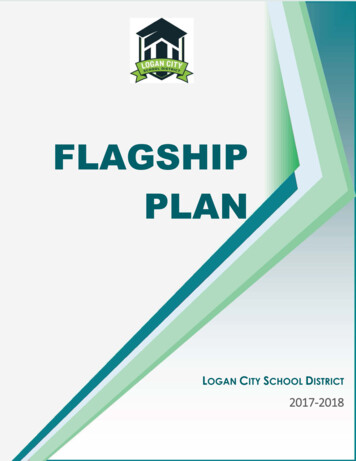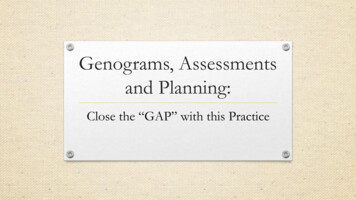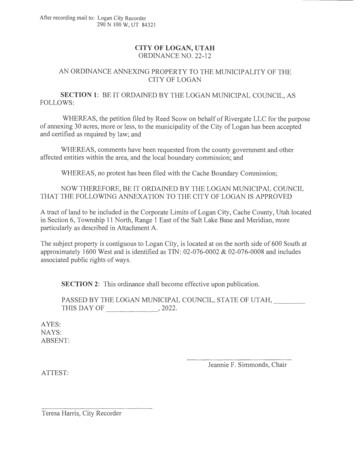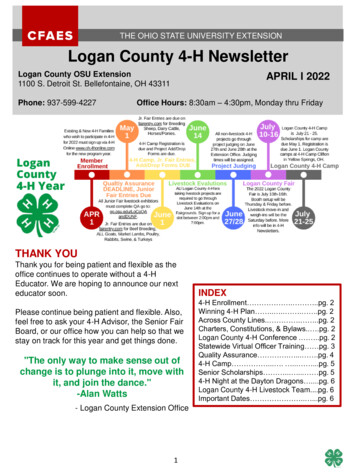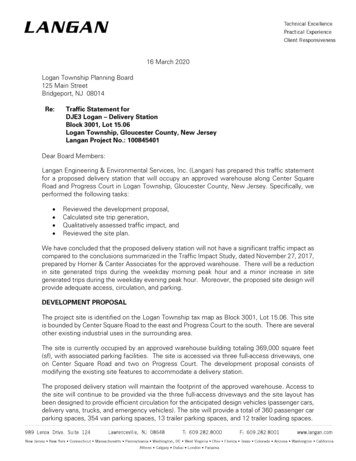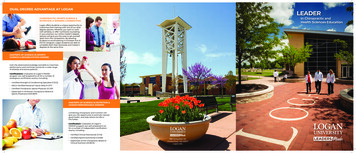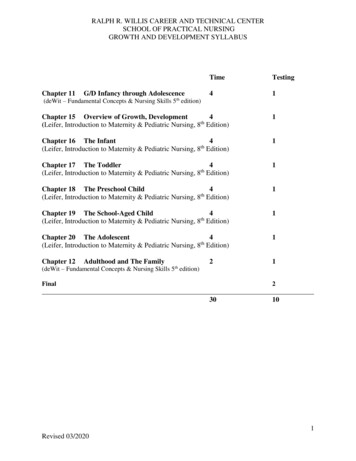
Transcription
RALPH R. WILLIS CAREER AND TECHNICAL CENTERSCHOOL OF PRACTICAL NURSINGGROWTH AND DEVELOPMENT SYLLABUSChapter 11G/D Infancy through AdolescenceTimeTesting41(deWit – Fundamental Concepts & Nursing Skills 5th edition)Chapter 15 Overview of Growth, Development4(Leifer, Introduction to Maternity & Pediatric Nursing, 8th Edition)1Chapter 16 The Infant4(Leifer, Introduction to Maternity & Pediatric Nursing, 8th Edition)1Chapter 17 The Toddler4th(Leifer, Introduction to Maternity & Pediatric Nursing, 8 Edition)1Chapter 18 The Preschool Child4(Leifer, Introduction to Maternity & Pediatric Nursing, 8th Edition)1Chapter 19 The School-Aged Child4(Leifer, Introduction to Maternity & Pediatric Nursing, 8th Edition)1Chapter 20 The Adolescent4th(Leifer, Introduction to Maternity & Pediatric Nursing, 8 Edition)1Chapter 121Adulthood and The Family2(deWit – Fundamental Concepts & Nursing Skills 5th edition)Final230101Revised 03/2020
RALPH R. WILLIS CAREER AND TECHNICAL CENTERSCHOOL OF PRACTICAL NURSINGGROWTH AND DEVELOPMENT SYLLABUSCourse Hours:Theory Hours:Clinical Hours IntegratedWVEIS:4040Textbooks1.2.3.deWitt, Susan C. / O’Neal, Patricia; FUNDAMENTAL CONCEPTS AND SKILLS FORNURSING Saunders/Elsevier; 5rth. edition; 2017.deWitt, Susan C. / O’Neal, Patricia; STUDY GUIDE FOR FUNDAMENTAL CONCEPTS &SKILLS FOR NURSING, Philadelphia, Elsevier/Saunders; 5rth. edition; 2017.Leifer, Gloria; INTRODUCTION TO MATERNITY & PEDIATRIC NURSINGSaunders/Elsevier; 8th edition; 2019.Course DescriptionThe purpose of this course is to introduce the practical nursing student to the variances of growthand development that occur during each stage of the lifespan. The lifespan begins during theprenatal period and continues through late adulthood. Family lifestyles will be studied as well asthe theorists who researched the cognitive and psychosocial development in children and adults.These principles, using the nursing process, will be applied to clients in various health caresettings.Course ObjectivesAfter completion of this course the student will:1.Identify normal growth and development of an individual throughout the lifespan.2.Utilize knowledge of growth and development principles by applying them to thedevelopment of nursing care plans for clients of all ages with various medical and surgicalconditions from infancy through the older adult stage including the grief stages associated withthe dying process.Discuss the practical nurse’s role in the relationship to the assessment, implementation, andevaluation of a family.Identify the basic concepts of marriage and family.Discuss and apply concepts of psychoanalytical and psychosocial development.Discuss theories of development according to Piaget’s, Kohlberg, Erikson, and Freud.3.4.5.6.Clinical PracticumCompleted in Acute, Long-Term Care and Community Health.Methods of Teaching1.Lecture, discussion, role playing emphasizing critical thinking2.Videos3.PowerPoint2Revised 03/2020
RALPH R. WILLIS CAREER AND TECHNICAL CENTERSCHOOL OF PRACTICAL NURSINGGROWTH AND DEVELOPMENT SYLLABUS5.6.7.9.10.DemonstrationIndividual and Group ConferenceWritten ExamsClinical PracticeEvaluationsStudent Responsibilities1.Read assigned chapter.2.Refer to and follow student monthly calendar for exam dates.3.Attend lectures and demonstrations.3.Complete activities as assigned.5.Participate in class/lab activities.6.Discuss critical thinking activities associated with the lesson.7.Refer and follow the policies as outlined and discussed in the Student Handbook.8.Pass exams with a grade of 80% or higher.Methods of Evaluation1.The following letter grade system is utilized for theory:A93 - 100B87 - 92C80 - 86F79 - 02.The following grading calculation is utilized for theory:Exams 60%Quizzes 10%Final 30%Evaluation Tools:a. Oral Presentationsb. Written Examsc. Laboratory Skillsd. Homework Assignmentse. Computer Examsf. Clinical Skills4.Make-up Exam:A student who misses an exam must be prepared to take the exam upon immediate returnto the classroom setting or as designated by the instructor. Students will automaticallyhave 5% deducted. Students not making up exam on the morning of return to the classroom willreceive a (0) zero.5.Quizzes:Students who are absent during a quiz will receive a Zero. Quizzes are NOT made up.6.7.See student monthly calendar for schedule of exam dates.See Student Handbook for clinical grading guidelines3Revised 03/2020
RALPH R. WILLIS CAREER AND TECHNICAL CENTERSCHOOL OF PRACTICAL NURSINGGROWTH AND DEVELOPMENT SYLLABUSChapter 11Growth and Development Infancy through Adolescence(deWit – Fundamental Concepts & Nursing Skills 5th edition)Instructor ProvidedLesson Content: 4 HRSTesting: 1HRLesson Content:I.Key TermsII.Overview of Structure and FunctionIII.Age-GroupsIV.Theories of DevelopmentA.Sigmund FreudB.Erik EriksonC.Jean PiagetD.Lawrence KohlbergV.Principles of Growth and DevelopmentVI.Prenatal DevelopmentA.Events In Prenatal DevelopmentB.Maternal InfluencesVII.InfantsA.Appearance And Capabilities Of NewbornsB.NutritionC.Physical DevelopmentD.Motor DevelopmentE.Cognitive DevelopmentF.Psychosocial DevelopmentVIII.Young ChildrenA.Physical DevelopmentB.Motor DevelopmentC.Cognitive DevelopmentD.Psychosocial DevelopmentE.Day Care And Early EducationIX.Middle and Older ChildrenA.Physical DevelopmentB.Cognitive Development4Revised 03/2020
RALPH R. WILLIS CAREER AND TECHNICAL CENTERSCHOOL OF PRACTICAL NURSINGGROWTH AND DEVELOPMENT SYLLABUSC.D.E.X.Psychosocial DevelopmentParentingChild AbuseAdolescentsA.Physical DevelopmentB.SexualityC.Cognitive DevelopmentD.Psychosocial DevelopmentE.Tasks of AdolescenceF.Concerns in Adolescent Developmenta.Pregnancyb.Employmentc.Chemical Abused.Eating Disorderse.DepressionLesson Objectives:After completion of this chapter the student will:1.Describe prenatal development.2.Compare the development of the male and the female.3.Discuss Freud’s theory of personality and the mind.4.Explain the stages of Erikson’s theory of psychosocial development.5.Explain the stages of Piaget’s theory of cognitive development.6.Discuss moral development according Kohlberg.7.Identify the principles of growth and development.8.Describe the physical development of children.9.Identify two pros and two cons of early childhood education.10.Discuss age-appropriate discipline measures for children.11.Explain the male and female physical changes of puberty.12.Identify developmental tasks of adolescence.13.Discuss at least three concerns related to adolescence.Clinical Practice:1.Explain the importance of regular prenatal health care.2.Discuss recommended feeding patterns for newborns and older infants.3.Explain the importance of screening young children for physical development.4.Provide health promotion teaching to parents and school-age children.5.Explain how parents and other caregivers can encourage age-appropriate cognitive andpsychosocial development.5Revised 03/2020
RALPH R. WILLIS CAREER AND TECHNICAL CENTERSCHOOL OF PRACTICAL NURSINGGROWTH AND DEVELOPMENT SYLLABUSChapter 15An Overview of Growth, Development, and Nutrition(Leifer, Introduction to Maternity & Pediatric Nursing, 8th Edition)Instructor ProvidedLesson Content:4 HRSTesting: 1 HRLesson Content:I.Key TermsII.Growth and DevelopmentA. The Impact of Growth and Development On Nursing CareB. TerminologyC. Directional PatternsD. Some Developmental Differences Between Children and Adults1. Height2. Weight3. Body Proportions4. Metabolic Rate5. Respirations6. Cardiovascular System7. Immunity8. Kidney Function9. Nervous System10. Sleep Patterns11. Bone GrowthE. Critical PeriodsF. Integration of SkillsG. Growth StandardsH. Developmental ScreeningI. Influencing Factors1. Hereditary Traits2. Nationality and Race3. Ordinal Position in the Family4. Gender5. Environment6. The FamilyJ. Personality Development1. Cognitive Development2. Moral DevelopmentK. The Growth and Development of a ParentIII.NutritionA. Nutritional HeritageB. Family Nutrition6Revised 03/2020
RALPH R. WILLIS CAREER AND TECHNICAL CENTERSCHOOL OF PRACTICAL NURSINGGROWTH AND DEVELOPMENT SYLLABUSC. Nutritional Care PlanD. Nutrition and HealthE. Nutrition and Health PromotionF. Feeding The Healthy Child1. The Infant2. The Toddler3. The Preschool Child4. The School-Age Child5. The Adolescenta.Childhood ObesityG. Feeding The Ill Child1. Food-Drug InteractionsH. The Teeth1. Deciduous Teeth2. Permanent Teeth3. Oral Care in Health and IllnessIV.PlayV.Ongoing Health SupervisionLesson Objectives:After completion of this chapter the student will:1.Define each key term listed.2.Explain the differences between growth, development, and maturation.3.Recognize and read a growth chart for children.4.List five factors that influence growth and development.5.Discuss the nursing implications of growth and development.6.Discuss the importance of family-centered care in pediatrics.7.Recognize the influence of the family and cultural practices on growth, development,nutrition, and health care.8.Describe three developmental theories and their impact on planning the nursing care ofchildren.9.Discuss the nutritional needs of growing children.10.Differentiate between permanent and deciduous teeth, and list the times of their eruption.11.Understand the characteristics of play at various age levels.12.Describe the relationship of play to physical, cognitive, and emotional development.13.Understand the role of computers and computer games in play at various ages.14.Define therapeutic play.15.Understand the use of play as an assessment tool.7Revised 03/2020
RALPH R. WILLIS CAREER AND TECHNICAL CENTERSCHOOL OF PRACTICAL NURSINGGROWTH AND DEVELOPMENT SYLLABUSChapter 16The Infant(Leifer, Introduction to Maternity & Pediatric Nursing, 8th Edition)Instructor ProvidedLesson Content: 4 HRSTesting: 1 HRLesson Content:I.Key TermsII.General CharacteristicsA.Oral StageB.Motor DevelopmentC.Emotional DevelopmentD.Need for Constant Care and GuidanceIII.Development and CareIV.Community-Based Care: A Multidisciplinary TeamA.Health Promotion1.Role of the Nurse2.Infants with Special NeedsB.Illness Prevention1.Immunizations2.Nutrition Counselinga. Parental Concernsb. Breastfeeding and Bottle Feeding1. Types of Infant Formula2. Safe Bottle Feedingc. Adding Solid Foodsd. Recommended Fat Intake During Infancye. Buying, Storing, and Serving Foodsf. Weaningg. Organic and Natural FoodsV.Infant SafetyA.Car SafetyB.Fall PreventionC.Toy SafetyVI.Summary of Major Developmental Changes in The First YearLesson Objectives:After completion of this chapter the student will:1.Define each key term listed.8Revised 03/2020
RALPH R. WILLIS CAREER AND TECHNICAL CENTERSCHOOL OF PRACTICAL NURSINGGROWTH AND DEVELOPMENT .Describe the physical and psychosocial development of infants from age 1 to 12 months,listing age-specific events and guidance when appropriate.Discuss the major aspects of cognitive development in the first year of life.Relate the nursing responsibilities in health promotion and illness prevention of infantsduring the first year of life.Discuss the nutritional needs of growing infants.Compare breastfeeding, bottle feeding, and the various infant formulas available.Describe how to select and prepare solid foods for the infant.List four common concerns of parents about the feeding of infants.Discuss the development of feeding skills in the infant.Compare and contrast natural, organic, and processed foods.Examine nutritional counseling for the infant.Identify the approximate age for each of the following: posterior fontanelle has closed;central incisors appear; birth weight has tripled; child can sit steadily alone; child showsfear of strangers.Describe normal vital signs for a 1-year-old infant.Discuss safety issues in the care of infants.Discuss the approach to and the specifics of care of an infant with colic.Identify age-appropriate toys and their developmental or therapeutic value.Discuss principles of safety during infancy.Discuss the development of favorable sleep patterns.9Revised 03/2020
RALPH R. WILLIS CAREER AND TECHNICAL CENTERSCHOOL OF PRACTICAL NURSINGGROWTH AND DEVELOPMENT SYLLABUSChapter 17The Toddler(Leifer, Introduction to Maternity & Pediatric Nursing, 8th Edition)Instructor ProvidedLesson Content: 4 HRSTesting: 1 HRLesson Content:I.Key TermsII.General CharacteristicsA.Physical DevelopmentB.Sensorimotor and Cognitive DevelopmentC.Speech DevelopmentIII.Guidance and DisciplineIV.Daily CareV.Toilet IndependenceVI.Nutrition CounselingVII.Injury PreventionA. Consumer EducationVIII.Toys and PlayLesson Objectives:After completion of this chapter the student will:1.Define each key term listed.2.Describe the physical, psychosocial, and cognitive development of children from 1 to 3years of age, listing age-specific events and guidance when appropriate.3.Discuss speech development in the toddler.4.Describe the task to be mastered by the toddler according to Erikson's stages of growthand development.5.List two developmental tasks of the toddler period.6.Discuss the principles of guidance and discipline for a toddler.7.Discuss how adults can assist small children in combating their fears.8.Identify the principles of toilet training (bowel and bladder) that will help guide parents’efforts to provide toilet independence.9.Describe the nutritional needs and self-feeding abilities of a toddler.10.List two methods of preventing the following: automobile accidents, burns, falls,suffocation and choking, poisoning, drowning, electric shock, and animal bites.11.Describe the characteristic play and appropriate toys for a toddler.10Revised 03/2020
RALPH R. WILLIS CAREER AND TECHNICAL CENTERSCHOOL OF PRACTICAL NURSINGGROWTH AND DEVELOPMENT SYLLABUSChapter 18The Preschool Child(Leifer, Introduction to Maternity & Pediatric Nursing, 8th Edition)Instructor ProvidedLesson Content: 4 HRSTesting: 1 HRLesson Content:I.Key TermsII.General CharacteristicsA.Physical DevelopmentB.Cognitive DevelopmentC.Effects of Cultural PracticesD.Language DevelopmentE.Development of PlayF.Spiritual DevelopmentG.Sexual Curiosity1. MasturbationH.Bedtime HabitsIII.Physical, Mental, Emotional, and Social DevelopmentA.The Three-Year-OldB.The Four-Year-Old1. The Concept of DeathC.The Five-Year-OldIV.GuidanceA.Discipline and Limit Setting1. Timing and Time-Out2. Reward3. Consistency and ModelingB.JealousyC.Thumb SuckingD.Enuresis1. Pathophysiology2. Treatment and Nursing CareV.PreschoolVI.Daily CareA.ClothingB.Accident Prevention11Revised 03/2020
RALPH R. WILLIS CAREER AND TECHNICAL CENTERSCHOOL OF PRACTICAL NURSINGGROWTH AND DEVELOPMENT SYLLABUSVII.Play in Health and IllnessA.Value of PlayB.The Nurse’s RoleC.Types of Play1. Play and the Handicapped Child2. Therapeutic Play3. Play Therapy4. Art TherapyVIII.Nursing Implications of Preschool Growth and DevelopmentLesson Objectives:After completion of this chapter the student will:1.Define each key term listed.2.List the major developmental tasks of the preschool-age child.3.Describe the physical, psychosocial, and spiritual development of children from age 3 to5 years, listing age-specific events and guidance when appropriate.4.Discuss the development of positive bedtime habits.5.Discuss one method of introducing the concept of death to a preschool child.6.Describe the development of the preschool child in relation to Piaget's, Erikson's, andKohlberg's theories of development.7.Discuss the characteristics of a good preschool.8.Discuss the value of play in the life of a preschool child.9.Designate two toys suitable for the preschool child, and provide the rationale for eachchoice.10.Describe the speech development of the preschool child.11.Discuss the value of the following: time-out periods, consistency, role modeling, andrewards.12.Discuss the approach to problems such as enuresis, thumb sucking, and sexual curiosityin the preschool child.13.Describe the developmental characteristics that predispose the preschool child to certainaccidents, and suggest methods of prevention for each type of accident.14.Explain the use of therapeutic play with a handicapped child.12Revised 03/2020
RALPH R. WILLIS CAREER AND TECHNICAL CENTERSCHOOL OF PRACTICAL NURSINGGROWTH AND DEVELOPMENT SYLLABUSChapter 19The School-Aged Child(Leifer, Introduction to Maternity & Pediatric Nursing, 8th Edition)Instructor ProvidedLesson Content: 4 HRSTesting: 1 HRLesson Content:I.Key TermsII.General CharacteristicsA.Physical DevelopmentB.Sexual Development1. Gender Identity2. Sex Educationa. Sexually Transmitted InfectionsIII.Influences from The Wider WorldA.School-Related TasksB.PlayC.Observing PlayD.Latchkey ChildrenIV.Physical, Mental, Emotional, and Social DevelopmentA.The Six-Year-OldB.The Seven-Year-OldC.The Eight-Year-OldD.The Nine-Year-OldE.Preadolescence1. The Ten-Year-Old2. The Eleven- and Twelve-Year-Olds3. Chores as Teaching ToolsV.Guidance and Health SupervisionA.Health ExaminationsB.Pet Ownership13Revised 03/2020
RALPH R. WILLIS CAREER AND TECHNICAL CENTERSCHOOL OF PRACTICAL NURSINGGROWTH AND DEVELOPMENT SYLLABUSLesson Objectives:After completion of this chapter the student will:1.Define each key term listed.2.Describe the physical and psychosocial development of children from 6 to 12 years ofage, listing age-specific events and type of guidance where appropriate.3.Discuss how to assist parents in preparing a child for school.4.List two ways in which school life influences the growing child.5.Contrast two major theoretical viewpoints of personality development during the schoolyears.6.Discuss accident prevention in this age-group.7.Discuss the role of the school nurse in providing guidance and health supervision for theschool-age child.8.Discuss the value of pet ownership for the healthy school-age child and the familyeducation necessary for the allergic or immunocompromised child.14Revised 03/2020
RALPH R. WILLIS CAREER AND TECHNICAL CENTERSCHOOL OF PRACTICAL NURSINGGROWTH AND DEVELOPMENT SYLLABUSChapter 20The Adolescent(Leifer, Introduction to Maternity & Pediatric Nursing, 8th Edition)Instructor ProvidedLesson Content: 4 HRSTesting: 1 HRLesson Content:I.Key TermsII.General CharacteristicsIII.Growth and DevelopmentA.Physical Development1. Boys2. GirlsB.Psychosocial Development1. Sense of Identity2. Sense of Intimacy3. Cultural and Spiritual Considerations4. Body Image5. Peer Relationships6. Career Plans7. ResponsibilityC.Cognitive Development1. DaydreamsD.Sexual Development1. Sexual Behavior2. Sex Education3. Concerns About Being “Different”4. HomosexualityIV.Parenting The AdolescentV.Health Promotion and GuidanceA.Nutrition1. Vegetarian Diets2. Sports and Nutrition3. Nutrition and School ExaminationsB.Personal Care1. Hygiene2. Dental Health3. SunbathingC.Safety1. Sports Injuries15Revised 03/2020
RALPH R. WILLIS CAREER AND TECHNICAL CENTERSCHOOL OF PRACTICAL NURSINGGROWTH AND DEVELOPMENT SYLLABUSVI.Common Problems of AdolescenceA.Substance AbuseB.DepressionC.Adolescent PregnancyVII.The Nursing Approach to AdolescentsLesson Objectives:After completion of this chapter the student will:1.Define each key term listed.2.List major physical changes that occur during adolescence.3.Identify two major developmental tasks of adolescence.4.Discuss three major theoretical viewpoints on the personality development ofadolescents.5.List five life events that contribute to stress during adolescence.6.Describe Tanner's stages of breast development.7.Describe menstruation to a 13-year-old girl.8.Identify two ways in which a person's cultural background might contribute to behavior.9.Discuss the importance of peer groups, cliques, and best friends in the developmentalprocess of an adolescent.10.List three guidelines of importance for the adolescent participating in sports.11.Summarize the nutritional requirements of the adolescent.12.Discuss two main challenges during the adolescent years to which the adolescent mustadjust.13.List a source for planning sex education programs for adolescents.14.Discuss the common problems of adolescence and the nursing approach.16Revised 03/2020
RALPH R. WILLIS CAREER AND TECHNICAL CENTERSCHOOL OF PRACTICAL NURSINGGROWTH AND DEVELOPMENT SYLLABUSChapter 12Adulthood and The Family(deWitt – Fundamental Concepts & Nursing Skills 5th edition)Instructor ProvidedLesson Content: 2 HRSTesting: 1 HRLesson Content:I.Key TermsII.Adulthood as Continuing ChangeIII.Theories of DevelopmentA.Schaie’s Theory of Cognitive DevelopmentB.Erikson’s Stages pf Adult Psychosocial DevelopmentIV.FamiliesA.Types of FamiliesB.Historical Changes In FamiliesC.Divorce and FamiliesV.Young AdultsA.Physical DevelopmentB.Health Concerns of Young Adults1. Risky Behavior2. Stress-Related Illness3. Early DiseaseC.Cognitive Development1. Continuing Education2. Careers and WorkD.Psychosocial DevelopmentE.Developmental Tasks1. Marriage2. Parenting3. Home Management4. Developing a Social Group5. Community ResponsibilityVI.Middle AdulthoodA.Physical DevelopmentB.Health ConcernsC.Cognitive Development1. Work Life2. Lifelong LearningD.Psychosocial Development1. Marriage17Revised 03/2020
RALPH R. WILLIS CAREER AND TECHNICAL CENTERSCHOOL OF PRACTICAL NURSINGGROWTH AND DEVELOPMENT SYLLABUS2.3.4.5.FriendshipsParentingCaring For ParentsGenerativityLesson Objectives:Upon completion of this chapter the student will:1. Define key terms.2. List three stages of adulthood.3. Explain Schaie’s theory of cognitive development in young and middle adults.4. Discuss Erickson’s stages of psychosocial development in young and middle adults.5. List at least three functions of families.6. Describe the effects of divorce on involved persons.7. Describe the physical and psychosocial development and changes of young and middleadults.8. Design an educational program to help adults maintain a healthy lifestyle.9. Identify at least three health concerns of young adults.10. Identify at least four health concerns of middle adults.11. Explain how caring people can nourish the cognitive and psychosocial development ofadults.18Revised 03/2020
RALPH R. WILLIS CAREER AND TECHNICAL CENTERSCHOOL OF PRACTICAL NURSINGGROWTH AND DEVELOPMENT SYLLABUSFinal2 hr.Students will take and pass the final with a minimum of 80% total average for the course.19Revised 03/2020
2. Explain the differences between growth, development, and maturation. 3. Recognize and read a growth chart for children. 4. List five factors that influence growth and development. 5. Discuss the nursing implications of growth and development. 6. Discuss the importance of family-centered care in pediatrics. 7.
